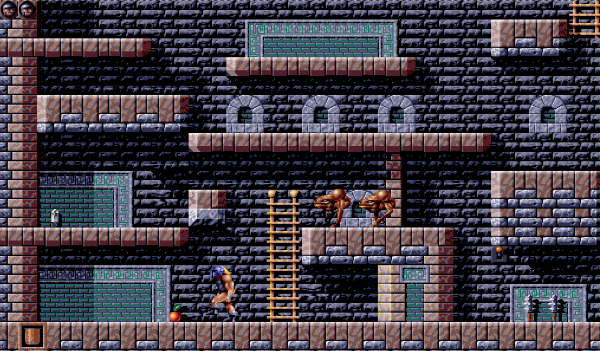© 2017, Nicolas Ramz (@warpdesign). MIT licence.
A simple framework for building 2D games in HTML5 and JavaScript like this one:
Here is a non-exhaustive list of features of AthenaJS:
- Unlimited number of scenes with an unlimited number of sprites
- Image-based Sprites with any number of animations
- Tiles-based Maps with horizontal & vertical scrolling
- Special scene transition effects like Fades, Mosaic can be added easily
- Map VS Sprite and Sprite vs Sprite collision detection
- Map Triggers support
- Sound support with volume and horizontal panning
- Keyboard & Joytisck input event supported (touch support is planned)
npm install athenajs --save
ES2015
import { Game, Scene, SimpleText } from 'athenajs';
// create a new game
const myGame = new Game({
name: 'first-game',
width: 320,
height: 200
}),
// create a new empty scene
myScene = new class MyScene extends Scene{
start() {
const myText = new SimpleText('my text', {
text: 'This is a test',
color: 'black'
});
// add the object onto the scene
this.addObject(myText);
}
};
// play this scene
myGame.setScene(myScene);ES5
in your html file:
<script type="text/javascript" src="athenajs.js"></script>
<script type="text/javascript">
window.onload = function () {
var Game = AthenaJS.Game,
Scene = AthenaJS.Scene,
SimpleText = AthenaJS.SimpleText;
// create a new game
var myGame = new Game({
name: 'first-game',
width: 320,
height: 200
});
// first extend the scene class which results in lots of code in Es5
// call Scene constructor from MyScene constructor
function MyScene() {
Scene.call(this);
}
// inherit from Scene.prototype
MyScene.prototype = Object.create(Scene.prototype);
// redefine the start() method
MyScene.prototype.start = function () {
var myText = new SimpleText('my text', {
text: 'This is a test',
color: 'black'
});
// add the object onto the scene
this.addObject(myText);
}
// finally correctly set the constructor to MyScene
MyScene.prototype.constructor = MyScene;
var myScene = new MyScene();
// // play this scene
myGame.setScene(myScene);
};
</script>If you are interested in contributing to the AthenaJS code base, simply fork the repository and make a pull-request.
Once you have cloned the repository, simply type:
npm install && npm link && npm startThis will install the prerequisites, add a link to athenajs into your global npm modules directory and build & start watching for changes.
Now to start using athenaJS for testing, simply type the following in the directory of your project using AthenaJS:
npm link athenajsThis will add a link from your project to the global athenajs link that was just created.
Athena JS icon by Icons8. Used under open-source licence.
Copyright (c) Nicolas Ramz.
Licensed under the MIT License.




